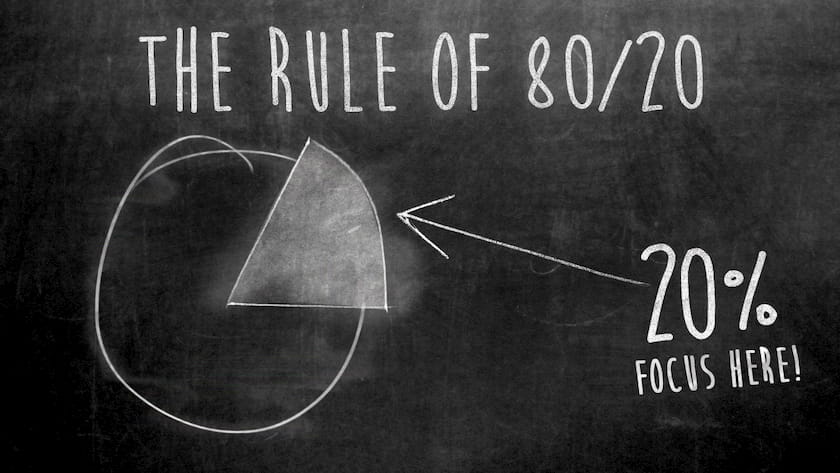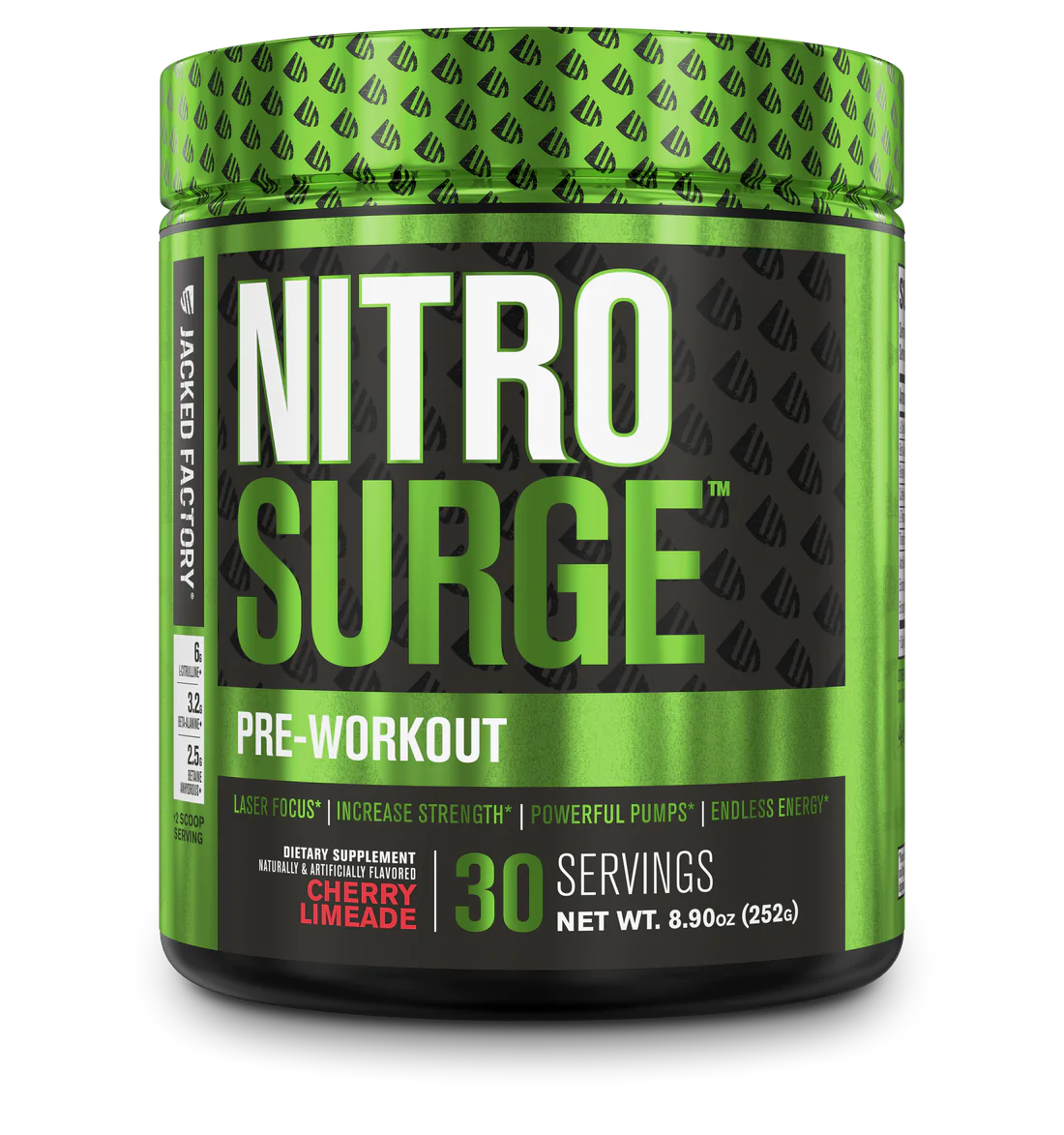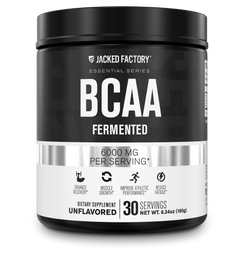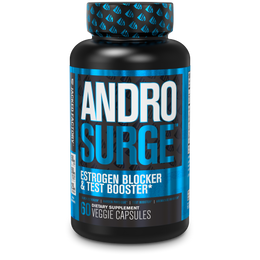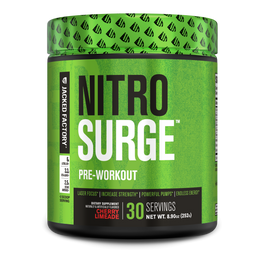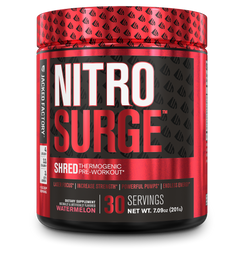When it comes to building muscle and shedding fat, gym-goers often find themselves preoccupied with trivial matters that have little bearing on the big picture.
For example, it’s not uncommon to see beginners focusing their time on iso-lateral BOSU ball lunges rather than basic barbell squats… it should be quite clear that the latter is going to build a much better set of legs (in much less time too).
Now don’t get me wrong, you should always be looking for ways to fine-tune your diet, training, and supplementation. However, it’s wise to consider that most things in life are not distributed evenly.
Enter Pareto’s Law: The 80/20 Principle
To elucidate this point, let’s consider the infamous Pareto principle that was originally founded upon the observation that 80% of Italy’s wealth belonged to only 20% of the population. Many people now refer to this as the “80/20” rule as it can apply to many facets of life.
80% of your results come from 20% of your inputs
For example, if you’re a business owner and you notice that 80% of your revenue comes from 20% of the customers, this is information that you can use to improve the efficiency of your marketing by focusing more on those customers.
It should be noted that the 80/20 rule is simply a rough guide about typical distributions; it is not a law of nature, and the numbers don’t need to add up to 100. The main thing to keep in mind is that many things in life (effort/reward/output) have uneven distributions.
There are infinitely more examples we could use, but let’s apply this to the health and fitness setting (I assume that’s why you’re reading this article after all).
What if I told you that 80% of your results come from 20% of the exercises in your current training routine?
Would you still waste your time focusing on the 80% of rather useless exercises that contribute very little to the final product? Or would you rather re-assess your program and put more effort into the 20% of exercises that are responsible for the majority of your results? I sure hope you would choose to focus on the more effective exercises.
Staying on the beaten path
Sadly, many people find themselves veering off the beaten path far too often when it comes to their training, diet, and supplementation. You must understand that there is diminishing marginal benefits the further away you stray from proven training methods, supplement ingredients, and dietary plan.
This is to say that you will be spending lots of time, money, and effort on activities that don’t really make much difference in the end; things that barely contribute to your long-term goals.
The good news is that you’ve found your way to Jacked Factory, so you’re in good hands.
This article will illustrate several major examples of how to implement the 80/20 rule in your training, diet, and supplementation regimens to help optimize your health and fitness progress. This will be especially helpful if you’re looking to build muscle and shed off those pesky love-handles.
Training Economy 101

If your goal is to be lean and muscular, then it should be rather intuitive that the majority of your time in the gym should be spent lifting weights. This is not to say that cardiovascular exercise doesn’t have a place in your regimen, but just that weight training is paramount to developing muscle tissue, strength, and metabolic capacity.
The trap that most people seem to slip into when they begin a fat-loss plan is focusing way too much on long bouts of cardio instead of hoisting some iron. Ultimately, these individuals just end up looking skinny and soft, like a marathon runner. Take note that “skinny” and “lean” are not synonyms; you can appear skinny but still have plenty of body fat.
Compare the physique of most any Olympic sprinter to that of an Olympic distance athlete and you’ll notice the sprinter is built quite like a bodybuilder. The reason for that is simple: the sprinters train with weights, and when they do cardio it’s mostly high-intensity interval training (HIIT) which has metabolic ramifications quite similar to weight training.
Exercise selection for optimal results
Muscle building is often seen as a very confusing process. There are so many workouts and articles that it can make it hard for gym-goers to see the bigger picture.
Bringing our trusty 80/20 principle back into context, it’s safe to say that the most efficient muscle-building exercises are going to be compound and multi-joint movements. They work on multiple muscle groups at once and allow for greater progression than isolation exercises. The most basic, fundamental compound exercises are the barbell bench press, squat, and deadlift.
Again, everything has its place in a sound training regimen, but keep the isolation exercises secondary to compound lifts. Each workout should be built around compound exercises that target the muscles you’re training that given day. For example, if you are training your upper body, a solid routine may look like this:
| Upper Body (Chest, Back, Abs) Example Workout | |
| Exercise | Type of Exercise |
| Deadlifts or Barbell Rows | Compound |
| Seated Cable Rows or Machine Rows | Compound |
| Pull Ups or Lat Pull Downs | Compound |
| Bench Press | Compound |
| Incline Dumbbell Bench Press | Compound |
| Dumbbell Flyes or Pec Dec | Isolation |
| Cable Crunches or Weighted Sit Ups | Isolation |
This gives us a total of 7 exercises in the workout, with 5 of those being compound movements. You could even superset many of these movements in an “A-then-B” fashion to save time and up the intensity of the program.
Ultimately, there are a plethora of ways you can structure your workouts, but it benefits you to spend the majority of your time focusing on compound movements and consistent progression. To give a rule-of-thumb, try and design your workouts so that you at least have a 2:1 ratio of compound to isolation movements.
Again, isolation exercises should certainly still be part of your regimen, but not the focus. Because isolation lifts are less taxing, they work better as finishing exercises, helping to work an already fatigued and taxed muscle.
Nutrition 101

The majority of your results will be determined by your total energy intake and your total energy output. The most important thing is to focus on calorie counting and control.
Studies show that overweight individuals who lessen their caloric intake to a level that is below their total energy use experience significant health benefits, both in appearance (such as reduced waist size) and internally. [1,2]
Now, this is not suggesting that macronutrient manipulation isn’t necessary or worthwhile since frankly, it is. However, if you’re not eating enough you won’t build muscle, just like you won’t lose fat if you’re not limiting calorie intake enough.
So if you’re new to tracking food intake, my advice is to first and foremost monitor your calorie intake. Once you are comfortable with that, move onto macronutrient tracking and manipulation.
The trickiest part of discussing nutrition is trying to provide a general guideline since dietary needs vary on an individual basis. However, there are still some guidelines to follow, and below you will find out how to apply them to create an optimal eating plan.
Nutritional Guidelines
1. Protein is crucial
Research seems to suggest that as long as the protein sources you ingest contains the necessary leucine content (and other essential amino acids) then there is little difference in MPS between sources (e.g. milk, animal protein, egg protein, etc). [3, 4]
Generally, 30+ grams of a leucine-rich protein source will provide good elevation in muscle protein synthesis for a solid 3-4 hours after ingestion. That being said, protein needs will vary for everyone based on their training regimen, age, and body composition.
2. Fats are essential, literally
Fatty acids have a variety of roles in sustaining cellular functions. Unsaturated fat sources, especially omega-3 fatty acids, are revered for their cardiometabolic health benefits. Also, saturated fatty acids are necessary for proper hormone production (mainly androgens).
Contrarily, consuming too much saturated fat is associated with insulin resistance and metabolic maladaptations, so don’t go overboard. [5]
As a baseline, start with about 25% of your total fat intake coming from saturated fats and emphasize unsaturated fats for the rest.
3. Carbohydrates are anabolic augmenters
Gym-goers often seem to have a love-hate attitude toward carbohydrates due to their inherent insulin production properties (save for fructose). However, some amino acids also help in the production of insulin, and more importantly, insulin is a potent anabolic hormone
Therefore, if you want to pack on some solid muscle tissue, it is beneficial to manipulate insulin secretion in your favor. Numerous studies have verified that the muscle protein synthesis response to a nominal dose of amino acids can be enhanced by the presence of an increased insulin response. [6,7]
Moreover, carbohydrates refill liver and muscle glycogen stores. The protein-sparing effect of carbohydrates is crucial to muscle building since fewer amino acids will be utilized for energetic purposes when sufficient glycogen and/or glucose is available.
4. Maximize pre-workout nutrition
Intense training causes several metabolic effects, such as upregulation of glucose transport proteins and enhanced blood flow in muscle tissue. It benefits you to take advantage of these favorable metabolic adaptations via proper nutrient intake around the time you train, generally by eating a generous amount of carbohydrates and protein.
This isn’t to say you shouldn’t take in any fat at this time either, but just not a high amount as fat can slow digestion and blunt insulin secretion.
5. Meal timing and frequency
The highest priority when dieting is meeting your calorie and macronutrient quotas at the end of the day, with the timing of those meals falling on the bottom. However, meal timing and frequency is still of relevance in the grand scheme of things, but the most important thing is to have a plan that allows you to consistently hit your calorie and macronutrient goals and perform at your best.
If this means eating 6-7 smaller meals every few hours or 2-3 bigger meals a day spaced further apart throughout the day then so be it. That being said, avoid very extreme protocols; eating all of your calories in one meal per day or eating every hour around the clock are certainly not very pragmatic approaches to performance nutrition.
6. Stay hydrated
This really should be a no-brainer, but don’t skimp on water, especially around the training time-frame. If you’re constantly thirsty or your urine is dark yellow, you are likely not drinking enough fluid. Try and carry a water bottle with you throughout the day and drink several ounces every hour.
Food choices and micronutrients

As far as food choices go, the majority of people can stand to benefit by emphasizing micronutrient-rich foods like fruits, vegetables, lean animal proteins, whole-grain carbohydrates, and healthy fat sources like various nuts and oils.
These don’t have to be your only food sources, but they will likely benefit your health and performance should you have them in your diet.
It is also important to ingest sufficient dietary fiber, micronutrients, and essential fatty acids; these maintain intestinal integrity, assist with mineral balance, heart health, and improve blood lipids. If you choose to supplement with a multi-vitamin or omega-3s that’s fine as well.
Supplementation
While supplements will never replace proper diet and training, they are certainly an important component of a health, fitness, and performance regimen. There are thousands upon thousands of supplements available these days so it can be quite overwhelming to decipher which ones are worthwhile and which are bunk.
Frankly, the 80/20 rule applies very well to supplementation since about 20% of the supplements out there are the ones that provide 80-90% of your results. Given this, the proceeding list is what I’ve found to be the most scientifically-proven and effective supplement ingredients that any gym-goer can benefit from:
1. Creatine monohydrate
Creatine monohydrate has stood the test of time when it comes to enhancing athletic performance. It’s one of the most effective supplements available when considering its cost-to-benefit ratio and safety.
It greatly bolsters ATP production and promotes water retention inside muscle cells, which thus upregulates protein synthesis. Studies concur that about 3-5g of creatine per day is necessary to sustain saturated intracellular levels. [8,9]
2. Whey protein
It goes without saying that whey protein is the gold standard protein supplementation if you’re looking to get the most out of your gym regimen. It has been shown to increase the anabolic response to resistance training, reduce sarcopenia from aging, boost insulin sensitivity, and enhance the immune system. [10-13]
It is the most bioavailable protein for humans and contains nominal amounts of all essential amino acids. Another big bonus is that whey protein is a convenient way to get more protein in your diet; simply use it as needed to hit your daily protein needs.
3. Citrulline malate
Citrulline is a nonessential amino acid found abundantly in the rind of watermelons. There appear to be many benefits to citrulline supplementation (especially when bound to malic acid) including increased nitric oxide production, decreasing muscle soreness after exercise, and enhancing the utilization of essential amino acids. [14,15,16]
Start with a daily dose of 6-8g, taken preferably pre-workout.
4. Caffeine
Many people probably already consume a rather hefty amount of caffeine in their daily routine (coffee in the morning or energy drinks in the afternoon). That being said, if you’re smart and methodical with your caffeine intake, it can be a great supplement to prepare you for the gym.
Caffeine decreases your perceived rate of exertion, thereby allowing you to push yourself harder and for longer than you normally could. [17] Moreover, caffeine is a psychostimulant that increases your focus and cognition. Aim for a dose of 1-3 mg per kg of body weight, about 30 minutes before training.
5. Multi-vitamins and fish oil
I like to combine these two supplements into their own category since they serve to sort of fill in any micronutrient gaps you may have in your diet. Generally, these two supplements will give you plenty of vitamins, minerals, and essential fatty acids to keep you healthy and performing at your best. Take your multi-vitamin as directed by the label and aim for about 2g of EPA & DHA (from fish oil) combined.
Wrap-Up
Hopefully, this article has helped you understand what the 80/20 rule is and how it can be applied to your diet, training, and supplementation. Again, be wary of focusing on minute details that don’t contribute much to your end goals.
The main point to take away from this article is that you want to focus more on things that have a large impact on your results and output. This may not be a very profound concept, but you’d be surprised when you take a step back and see just how inefficient some people are when it comes to their health and fitness. Be smart, be relentless, and stay committed to your goals.
References:
1. Hu, F. B., Manson, J. E., Stampfer, M. J., Colditz, G., Liu, S., Solomon, C. G., & Willett, W. C. (2001). Diet, lifestyle, and the risk of type 2 diabetes mellitus in women. New England Journal of Medicine, 345(11), 790-797.
2.Fontana, L., & Klein, S. (2007). Aging, adiposity, and calorie restriction. JAMA: the journal of the American Medical Association, 297(9), 986-994.
3.Katsanos CS, Kobayashi H, Sheffield-Moore M, Aarsland A, Wolfe RR. A high proportion of leucine is required for optimal stimulation of the rate of muscle protein synthesis by essential amino acids in the elderly. Am J Physiol Endocrinol Metab. 2006 Aug;291(2):E381-7. Epub 2006 Feb 28. PubMed PMID: 16507602.
4.Paddon-Jones D, Sheffield-Moore M, Katsanos CS, Zhang XJ, Wolfe RR. Differential stimulation of muscle protein synthesis in elderly humans following isocaloric ingestion of amino acids or whey protein. Exp Gerontol. 2006 Feb;41(2):215-9. Epub 2005 Nov 23. PubMed PMID: 16310330.
5.Kraegen, E. W., Clark, P. W., Jenkins, A. B., Daley, E. A., Chisholm, D. J., & Storlien, L. H. (1991). Development of muscle insulin resistance after liver insulin resistance in high-fat–fed rats. Diabetes, 40(11), 1397-1403.
6.O’Connor, P. M., Bush, J. A., Suryawan, A., Nguyen, H. V., & Davis, T. A. (2003). Insulin and amino acids independently stimulate skeletal muscle protein synthesis in neonatal pigs. American Journal of Physiology-Endocrinology And Metabolism, 284(1), E110-E119.
7.Kimball, S. R., Jurasinski, C. V., Lawrence, J. C., & Jefferson, L. S. (1997). Insulin stimulates protein synthesis in skeletal muscle by enhancing the association of eIF-4E and eIF-4G. American Journal of Physiology-Cell Physiology, 272(2), C754-C759.
8. Herda TJ, Beck TW, Ryan ED, Smith AE, Walter AA, Hartman MJ, Stout JR, Cramer JT:Effects of creatine monohydrate and polyethylene glycosylated creatine supplementation on muscular strength, endurance, and power output. J Strength Cond Res 2009, 23:818-826.
9. Balsom, P. D., Ekblom, B., Söerlund, K., Sjödln, B., & Hultman, E. (1993). Creatine supplementation and dynamic high‐intensity intermittent exercise.Scandinavian journal of medicine & science in sports, 3(3), 143-149.
10. Reidy PT, Walker DK, Dickinson JM, Gundermann DM, Drummond MJ, Timmerman KL, Fry CS, Borack MS, Cope MB, Mukherjea R, Jennings K, Volpi E, Rasmussen BB. Protein blend ingestion following resistance exercise promotes human muscle protein synthesis. J Nutr. 2013 Apr;143(4):410-6. doi: 10.3945/jn.112.168021. Epub 2013 Jan 23. PubMed PMID: 23343671
11. Drummond MJ, Dreyer HC, Pennings B, Fry CS, Dhanani S, Dillon EL, Sheffield-Moore M, Volpi E, Rasmussen BB. Skeletal muscle protein anabolic response to resistance exercise and essential amino acids is delayed with aging. J Appl Physiol. 2008 May;104(5):1452-61.
12. Frestedt JL, Zenk JL, Kuskowski MA, Ward LS, Bastian ED. A whey-protein supplement increases fat loss and spares lean muscle in obese subjects: a randomized human clinical study. Nutr Metab (Lond). 2008 Mar 27;5:8. doi: 10.1186/1743-7075-5-8. PubMed PMID: 18371214; PubMed Central PMCID: PMC2289832.
13. Castell L. Glutamine supplementation in vitro and in vivo, in exercise and in immunodepression. Sports Med. 2003;33(5):323-45.
14. Wijnands KA, Vink H, Briedé JJ, van Faassen EE, Lamers WH, Buurman WA, Poeze M. Citrulline a more suitable substrate than arginine to restore NO production and the microcirculation during endotoxemia. PLoS One. 2012;7(5):e37439
15. Hickner RC, Tanner CJ, Evans CA, Clark PD, Haddock A, Fortune C, Geddis H, Waugh W, McCammon M. L-citrulline reduces time to exhaustion and insulin response to a graded exercise test. Med Sci Sports Exerc. 2006 Apr;38(4):660-6. PubMed PMID: 16679980.
16. Pérez-Guisado, J., & Jakeman, P. M. (2010). Citrulline malate enhances athletic anaerobic performance and relieves muscle soreness. The Journal of Strength & Conditioning Research, 24(5), 1215-1222.
17. Doherty, M., & Smith, P. M. (2005). Effects of caffeine ingestion on rating of perceived exertion during and after exercise: a meta‐analysis. Scandinavian journal of medicine & science in sports, 15(2), 69-78.
